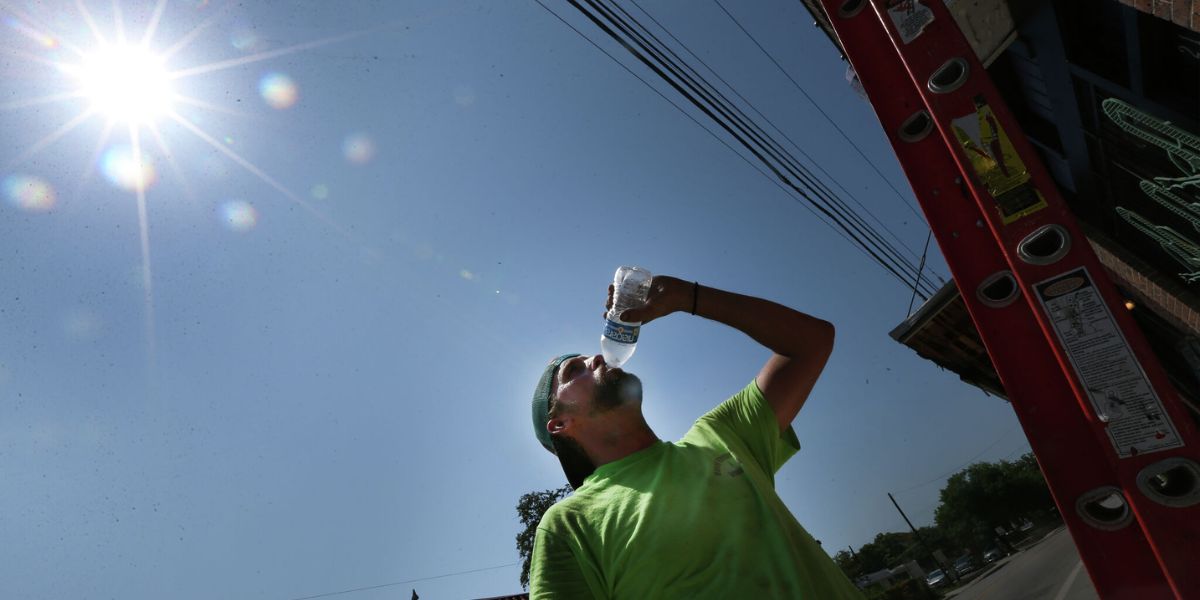Millions of Americans were on watch for potentially dangerous temperatures this week as sweltering heat, more often seen in the midst of summer than in the spring, made an unwanted visit to much of the United States, from the Dakotas to Texas and other regions of the South.
Forecasters in Austin cautioned that a century-old May temperature record of 104 degrees Fahrenheit (40 degrees Celsius) might be broken by the early heat wave.
Cameron Self, a meteorologist with the National Weather Service office in the Houston and Galveston region, stated that this week was “definitely more like August than May.”
Houston and neighbouring portions of Texas frequently experience May temperatures above 90 degrees Fahrenheit (32 degrees Celsius).
However, Self noted that extended periods of high 90s temperatures typically do not occur until June.
According to Texas state meteorologist John Nielsen-Gammon, the intense heat this week was expected to cause certain Texas cities to experience the longest run of triple-digit days they had ever experienced in June.
Recent days have seen record-breaking high temperatures in a number of North Dakota cities, with some breaking records that had stood for more than a century.
Texas and states in the southeastern U.S. were anticipated to endure this heat for at least the next week or so, while the northern section of the country is forecast to receive some reprieve from cooler air.
Why are the temperatures so unusually high?
The intense heat is caused by a very powerful ridge of high pressure over the south-central United States, which is centred over the Gulf of Mexico.
Much of the south central and southeastern United States will experience warmer-than-normal temperatures over the next six to ten days, with regions of Texas and Florida experiencing the greatest temperatures, according to Self.
According to Nielsen-Gammon, the same weather system that was warming Texas and other southern states was also responsible for the temperature spikes in the Dakotas, Minnesota, and other portions of the Midwest.
Read Also: Empowering Families: North Texas Organization Expands Aid to Moms and Kids
Record-breaking heat in the Dakotas, Minnesota, intensifies wildfire conditions
According to Mindy Beerends, meteorologist-in-charge for the National Weather Service in Grand Forks, North Dakota, the Dakotas, Minnesota, and southern Canada have seen very warm temperatures in recent days, up to 30 degrees above average for this time of year.
The previous record of 93 degrees Fahrenheit (33.89 degrees Celsius) set in 1887 was surpassed by Fargo’s high of 95 degrees Fahrenheit (35 degrees Celsius) on Sunday.
On Monday, Bismarck broke the 1880 record of 92 degrees Fahrenheit (33.33 degrees Celsius) by reaching 97 degrees Fahrenheit (36.11 degrees Celsius).
During a briefing on Tuesday, Governor Tim Walz and other state authorities stated that the extraordinarily high temperatures, extremely low humidity, and growing drought conditions had made fire conditions in northern Minnesota exceptionally risky.
Officials predicted that Thursday will see better weather, with showers and lower temperatures providing firefighters with a respite.
According to officials, Minnesota is now up to 970 wildfires, encompassing over 37,000 acres, including more than 80 since Sunday. Typically, the state sees a little over 1,100 wildfires, encompassing over 12,000 acres annually.
According to Brian Galvin, fire chief of the Goodrich Rural Fire Department in central North Dakota, the dry weather has caused explosive fires.
On Saturday, between 50 and 60 firefighters, farmers, and other individuals responded to a 200-acre fire that was spreading quickly close to Lincoln Valley.
For days, temperatures in certain parts of Texas might reach triple digits
According to Self, portions of Texas further west of the Gulf may experience temperatures well over 100 degrees, but areas closer to the Gulf of Mexico, like Houston, may see their temperatures “modified somewhat” because the water is still cold enough.
The National Weather Service predicted that through the weekend, high temperatures in San Antonio would surpass 100 degrees Fahrenheit (38 degrees Celsius).
In order to keep safe, the Texas Department of Public Safety advised locals to restrict their outside activities and drink plenty of water.
The Gulf of Mexico was renamed the Gulf of America by an executive order signed by Trump. The order is only enforceable in the United States. The Gulf of Mexico moniker is still used by other nations and international organisations.



